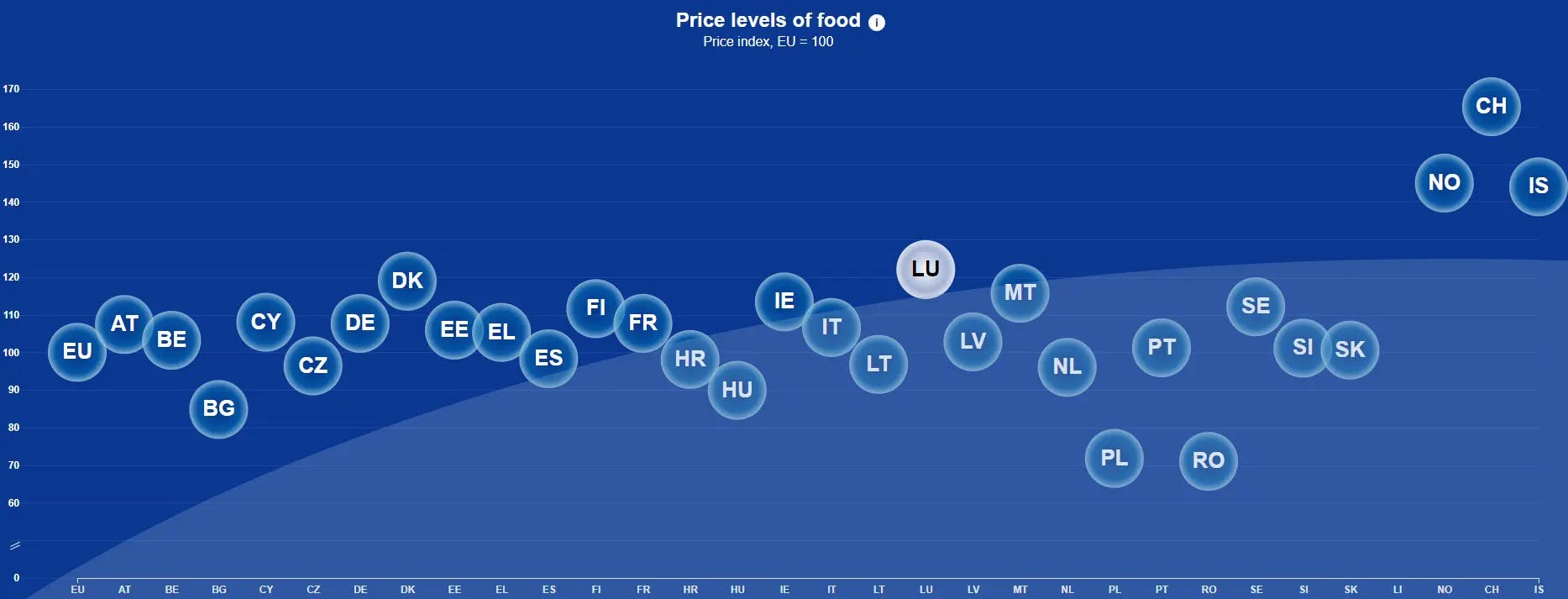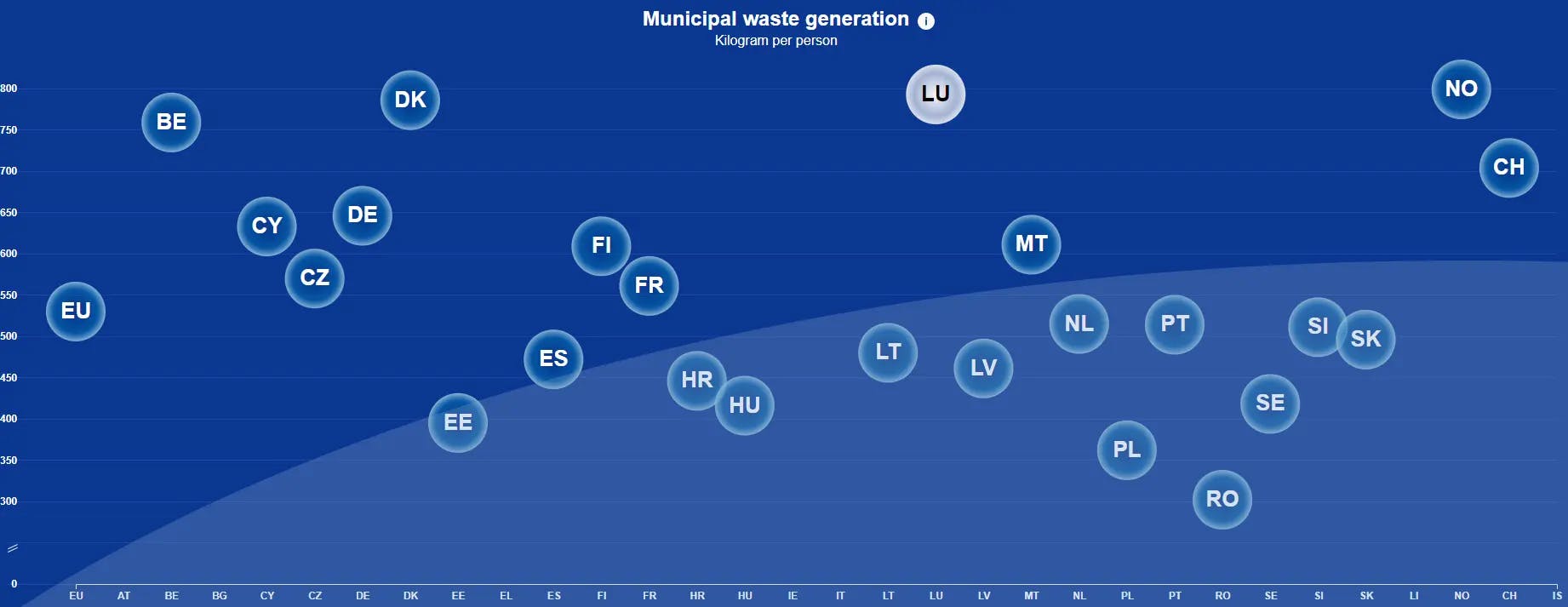Luxembourg in numbers: the country's key figures in graph form

Eurostat regularly produces large and interesting studies, and now it has decided to go even further. The agency has added a practical data visualization tool, so we jumped right in to see how Luxembourg compares with its neighbors. It turned out to be quite interesting!
Age of the population
The median age in Luxembourg is 40. This means that half of the country's population is younger and the other half is older.
Among EU countries, this is a fairly good result. Only Ireland, Iceland and Cyprus are lower. The neighbors in the Greater Region keep within 42-46 years.

Poverty of the population
This is an indicator that no one likes to publish, but official statistics are merciless and objective. It is worth noting that despite its highly demanding labor market and high taxes, Luxembourg ranks low on the poverty scale: only 19% of the population has an income below the subsistence level.
Belgium has the same figure, while France and Germany are slightly higher at 21% each. Romania and Bulgaria, on the other hand, have 34% and 32% of their populations living in poverty — one in three of their citizens is at risk of poverty.

Travel frequency
Luxembourgers are among the most passionate travelers. More than 76% of the population travels during their vacations. They are a few percentage points behind the Scandinavians, Finns and Irish, but still have one of the highest rates in Europe.
The least traveled, as expected, are the Romanians and Bulgarians. Unfortunately, this corresponds well with the previous indicator.

Price levels
Luxembourg has the highest GDP per capita - 119,230 euros. At the same time, prices for goods and services are far from the highest among EU member states. If we take the EU indicator as 100, Luxembourg has 137. In other words, it is just over a third more expensive to live in Luxembourg than in the EU.
For comparison: Switzerland's index reaches 174 (almost 2 times more expensive than the EU average), Iceland's is 159, Ireland and Denmark are almost at the same level — 146 and 145 respectively.

Price levels of food
This is one of the most important measures and is often examined separately. Here the differences are not so great, although Switzerland, Norway and Iceland are very far from their neighbors.
In Luxembourg, on the other hand, the cost of food is only 122, again compared to the EU average of 100. It is more expensive here, as you would expect, but a food product costing 10 euros in the Grand Duchy costs 12 euros, which does not sound as frightening as 16.5-17 euros.

Household spending on food and non-alcoholic drinks
Although prices are relatively high, Luxembourg spends less on food and soft drinks than any other EU country except Ireland. The Irish also spend only 9% of their income on food. Of course, the most important factor here is the income level of the population, compared to which food costs look very modest.
This is well confirmed by the indicators of Romania and Bulgaria, which, let us remember, remain among the poorest countries in the EU. Here the figures for food costs are 25% and 20% respectively.
As for neighboring Luxembourg, the French spend 14% of their salary on food, the Belgians — 13% and the Germans — 12%.

Waste generation
Well, Luxembourg should have had an anti-record. The amount of waste per person in the country is one of the highest in the EU — 793 kg per year. A little ahead of Norway with 799 kg, but the gap is not as big as we would like.
To be fair, Denmark and Belgium are close behind with 786 kg and 759 kg respectively. Romania, Poland and the Baltic States produce the least amount of garbage.

And, curiously, food waste is minimal here. A Luxembourger throws away only about 147 kg of food per year. It is worth noting that almost all EU countries stay within 100-150 kg, except Cyprus. Here, the amount of food wasted is simply off the scale: 397 kg with a total garbage of 633 kg — almost 2/3.

Recycling rate
In this context, recycling is a key issue. Germany has the highest percentage of household waste recycled, at 71%. Luxembourg recycles only 55%, despite strict sorting requirements. It is close to the Netherlands (58%), Slovenia (60%) and Belgium (53%).

Electric cars
Since we are talking about ecology, we cannot ignore electric cars, which many people see as a real replacement for gasoline, diesel and hybrid engines.
Once again, Germany is the leader. The country has 618,460 electric cars. This is followed by Norway with 465,410 and France with 402,669.
Luxembourg is far from the top in this ranking, with only 7,960 electric cars. Of course, these statistics do not take into account percentages, as the population of the Grand Duchy is slightly larger than the number of electric car owners in Germany.

You can view figures for other countries on the Eurostat website in a special visualization tool.





